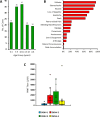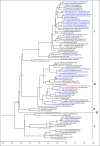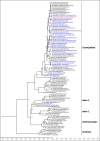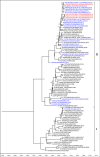Investigation of severe dengue outbreak in Maumere, East Nusa Tenggara, Indonesia: Clinical, serological, and virological features
- PMID: 39965014
- PMCID: PMC11835340
- DOI: 10.1371/journal.pone.0317854
Investigation of severe dengue outbreak in Maumere, East Nusa Tenggara, Indonesia: Clinical, serological, and virological features
Abstract
Background: Dengue, an acute febrile disease caused by dengue virus (DENV) infection, is endemic to Indonesia. During early 2020, an outbreak of severe dengue occurred in Maumere, East Nusa Tenggara province, a region with low dengue endemicity with limited data on the characteristics of the circulating DENV. By 18 March 2020, 1396 cases were reported with 14 fatalities. Investigation was conducted to understand the cause and characteristics of the outbreak.
Methods: Sera were collected from 133 patients with dengue-like symptoms through random sampling at TC Hillers Hospital, Maumere during outbreak between February and June 2020. Dengue was confirmed using NS1 and/or RT-PCR detection. Serological status was determined using IgG/IgM ELISA and plaque reduction neutralization test (PRNT). DENV serotyping and genome sequencing were performed to identify the DENV serotype and genotype.
Results: We recruited suspected dengue patients attending the hospital during the outbreak. Dengue was confirmed in 72.2% (96/133), while 18.8% (25/133) were diagnosed as probable dengue. Children under 18 years old accounted for 85.1% (103/121) of dengue cases. Severe dengue accounted for 94.2% (81/86) of cases. Secondary infections made up 92.6% (112/121) of cases. Serotyping detected 87.3% (62/71) as DENV-3, 7.0% (5/71) as DENV-4, 2.8% (2/71) as DENV-1, and 2.8% (2/71) as DENV-2. Phylogenetic analysis revealed close evolutionary relationship of Maumere DENV to viruses from other Indonesian regions, especially Bali and Kupang. PRNT on DENV-3 secondary infections patients detected the presence of DENV-2 and DENV-4 neutralizing antibodies.
Conclusion: The severe dengue outbreak in Maumere is caused by DENV-3 introduced from nearby islands. The high proportion of secondary infections likely contributes to the severity of the disease. The high percentage of anti-dengue neutralizing antibodies for multiple serotypes and the high proportion of anti-dengue IgG in young children suggests a history of dengue transmission with a high infection rate in the area.
Copyright: © 2025 Santoso et al. This is an open access article distributed under the terms of the Creative Commons Attribution License, which permits unrestricted use, distribution, and reproduction in any medium, provided the original author and source are credited.
Conflict of interest statement
The authors have declared that no competing interests exist.
Figures






References
-
- Principles of Epidemiology: Lesson 6, Section 1|Self-Study Course SS1978|CDC. 2021. Dec 20 [cited 2022 Apr 4]. Available from: https://www.cdc.gov/csels/dsepd/ss1978/lesson6/section1.html
-
- WHO-SEARO. Comprehensive guidelines for prevention and control of dengue and dengue haemorrhagic fever. Revised and expanded. New Delhi, India: World Health Organization; 2011.
-
- Ministry of Health of the Republic of Indonesia. Indonesia health profile 2019. 2020.
MeSH terms
Substances
LinkOut - more resources
Full Text Sources
Medical

